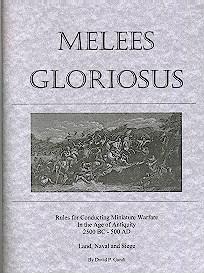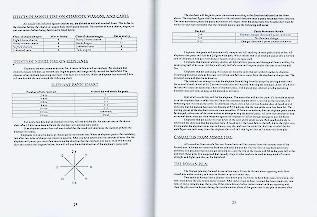
Melees Gloriosus

- the land game
Back to MELEES GLORIOSUS - DETAILED DESCRIPTION
Of Soldiers and Armies
Melees Gloriosus recognizes the following troop types:
- skirmishers
- light infantry
- peltasts
- heavy infantry
- phalangite/phalanx
- light cavalry
- heavy cavalry
- cataphract/clibanarii
- camelry
- elephants
- chariots (2-, 3-, 4-horse, and scythed)
- battlewagons (Sumerian type)
- artillery
These troop types are optional:
- scouts/messengers
- engineers
- camp followers
- armed peasant levies
- armed rabble
Individual troops are combined with others of their type to form units. Each unit receives a rating: raw, regular, veteran, or elite. A unit contains a maximum of 60 figures, including a mandatory command stand. (Irregular troops come in large units, while regular troops typically do not exceed 36 figures per unit.) The point cost of a unit is determined by the troop type value multiplied by the number of figures in the unit. Any number of units compose an army.
The number of commanders which an army has depends on the number of players per side, as there must be one figure to represent each player. One player is the commander-in-chief of each army, while the others are sub-commanders.
A thumbnail guide to several ancient armies is provided in an appendix, but no specific army lists are included. As the rules state, "Researching and organizing your army or armies can be one of the more enjoyable aspects of the hobby."
Sequence of Play
Each game turn is composed of the following steps:
- movement
- charge movement
- normal movement
- missile fire
- artillery fire
- other missile fire
- melee
- morale checks
- breakthrough movement (special advance by units victorious in melee)
Both players participate in each phase. For instance, at the start of the movement phase, players dice with the winner choosing whether to go first or force the other to go first. One player then moves his forces, followed by the other player moving his forces.
The optional rules insert a Command and Control phase at the start of each turn, with players spending command points to issue orders and control units. Uncontrolled units either stop, continue what they were doing, or do as the player desires, as determined by their rating and a dieroll.
Movement
Units may be in one of two possible formations - battleline and march-column. To change formation costs both movement points and time (rated in turns and half-turns). Similar costs apply to changing frontage (reducing or expanding the number of ranks), changing facing (rotating troops in place, so that the unit's front face is changed), and wheeling (actual rotation of the unit). Certain troops can use special maneuvers, such as side-stepping and incline movement.

Skirmishers are an exception to the normal formation and movement rules. Skirmishers act individually, may move as they feel, and pay no maneuver costs. Peltasts may change from skirmish to normal status.
Units in battleline formation have the option of performing a charge, but only if this is declared at the start of the movement phase. Charge movement is performed before all other movement. Certain units may use charge movement every other turn, as a form of increased movement, but most units can only declare a charge if they intend to make contact with the enemy.
Missile Combat
Cavalry, skirmishers, and light infantry may attack using ranged weapons -
- pila
- saunion
- foot spear
- mounted spear
- throwstick
- slings
- fundibalus
- foot bow
- mounted bow
- composite bow
- crossbow
To make an attack, the unit must have a target within range (determined by weapon type) and in their arc of fire (determined by troop type). Movement also determines whether a unit can make a ranged attack, and if so, how many figures in which ranks may attack.
In other to attack, a unit must have loaded weapons. Most weapons take one turn to reload, with movement restrictions applying during the reloading. In addition, weapons can only be loaded while ammunition exists. For weapons such as spears, the number of weapons per figure is specified before play; for bow-armed infantry, they fire at a penalty after five attacks, and must resupply after ten attacks.
Under certain conditions - after being fired upon, or within charge range of an enemy unit - a ranged-weapon unit must attack its priority target. Otherwise, the unit may select any eligible target. Units may even divide their attacks among eligible enemies. To gain a bonus, a unit may "aim" for up to two turns prior to firing.
| Missile combat in Melees Gloriosus is unique in that
indirect fire over other units into a target is recognized....this was a historically
accurate tactic in some armies...To disallow this is to eliminate a major aspect
of ancient warfare, and thus not give an accurate portrayal of combat from the
period.
Introduction and Design Philosophy Melees Gloriosus, pg. I |
There are two forms of ranged combat - direct fire, in which the firing unit can trace a line of sight to the target; and indirect fire, when firing "over" some troops or certain terrain features to target other soldiers. Indirect fire is less effective than direct fire, and will also hit any friendly troops too close to the intended target.
Missile fire is resolved by rolling a six-sided die, applying modifiers (due to range, cover, movement, target's armor, firing angle, aiming, target depth, and the firing unit's rating and nationality), then cross-referencing this score to the number of figures firing to discover how many "hits" were scored. Different combat tables are used for direct and indirect fire.
In general, one hit equals one kill, and the casualty is marked (using a casualty cap or other marker) from the rear rank of the target unit. However, targets such as chariots, wagons, and elephants take multiple hits to kill, and some hits may be negated (due to hitting the structure) or applied elsewhere (such as hitting an elephant's crew rather than the elephant itself). Hits may cause an elephant to panic.
| Example: A unit of 60 Celtic irregular bowmen fires on a unit of
36 Roman regular heavy infantry. Since the Celts moved at full speed this turn, only
half of their front rank may fire - in this case, 10 archers.
To resolve the attack, the Celtic player rolls a die and gets a "5." This is modified by: -2 (firing unit moved), +2 (target at short range, 6" or less for an infantry bow), -2 (target armored), for a final result of 5 - 2 + 2 - 2 = 3. Cross-referencing this score versus the number of figures firing (10), the player discovers the Celts have inflicted 2 hits on the Romans. The Roman player must mark two figures in his rear rank. |
Artillery attacks are similar to ordinary missile attacks, except that they are never required to attack, they usually take longer to reload, and they have a crew of between 1 and 6 figures (depending on weapon type). Each weapon is rated for its "worth" in terms of figures firing, and a different (smaller) set of modifiers apply to artillery fire resolution. Special rules apply to artillery firing at individuals, and against other artillery.
Melee Combat
Melee combat is resolved in a strict order, depending upon the type of units fighting and the nature of their engagement. (For instance, all skirmisher vs skirmisher combats are resolved first, before next resolving all attacks striking the rear of an enemy unit.)
The number of ranks which may participate in the attack depends on the weapon type being used, with longer weapons (i.e., pikes) allowing certain units in the second or even the third rank to count.
To resolve combat, the number of figures is determined. A dice is rolled and modified due to the attacker's rating, formation, depth advantage (heavy infantry only), movement, troop type, target's armor, rating, and charge bonus (if any). A modifier also applies due to the attacker's troop type compared to the defender's troop type. The final score is compared on a chart against the number of figures fighting to determine hits inflicted.
If an attacker successfully engages an enemy in melee from the side or rear, the defender may not perform melee (that is, can't attack back), and the attacker receives a bonus during combat resolution. (Rear attacks provide a greater bonus.)
Fatique also counts in melee. Units incur a fatique penalty according to the number of turns spent in melee, which may be partially reduced by resting.
Special melee rules apply to cavalry, chariots, camels, elephants, light infantry in support of cavalry, multiple units in melee, and Roman heavy infantry.
| Example: A unit of 34 Roman regular heavy infantry successfully
charge the 60 Celtic irregular bowmen who fired on them previously. The melee is
front-rank-to-front-rank, so it is resolved near the end of the melee phase.
The Romans have 20 men in their front rank, and no one in the other ranks counts for this melee. No ranking bonus applies (the Roman heavy infantry does not have more ranks than the Celts). These modifiers apply: +1 (veterans), +2 (heavy infantry vs. light infantry), +1 (heavy infantry charging), +2 (enemy unarmored), +1 (Roman manipular heavy infantry of the Republic), for a final modifier of +7. The Roman rolls a "2," which is modified to a 2 + 7 = 9. Comparing 20 men against a result of 9 equals 7 hits...7 dead Celts from the rear rank. The Celt attack must also be resolved. They too have 20 men in the front rank. They receive these modifiers: -2 (light infantry vs. heavy infantry), -2 (enemy armored), for a final modifier of -4. They roll a "6," modified to a "2," which compared to 20 fighters gives a result of 4 hits...4 dead Romans from the rear rank. |
Morale
During the Morale phase, certain units may be forced to take a morale check due to:
- casualties (taking 30% casualties, and once for every 10% reduction afterwards)
- seeing a commander killed
- seeing a friendly unit eliminated or routed
- being attacked in the flank or rear
- being "bumped" by a friendly retreating unit
Each unit has a Morale score based on its original rating, modified by the number of casualties taken. To succeed at the morale test, the player must roll equal to or less than the morale score on two dice. Modifiers apply due to presence of friendly units or commanders, nationality, being attacked in flank or rear, or seeing a commander killed or friendly unit eliminated or routed.
If the test is failed, the result depends on the unit's current morale score. The unit will retreat, may suffer a melee penalty, or might even be removed from play. The penalty applies until the unit succeeds at a morale check.
Victory
The rules suggest that players should determine victory conditions based on the scenario they are playing. As a substitute, defeat is incurred by the player who first loses half of his "main combat units." The definition of main combat units should be determined prior to play, but usually involves the heavy infantry units of an army.